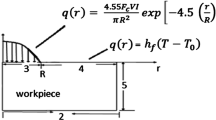Abstract
In this study, single discharge thermo-electrical model of workpiece material removal in electrical discharge machining (EDM) was developed. Developed model includes generation of energy in liquid media, variation of plasma channel radius and transfer of heat from the channel by the electrical discharge. Effect of generated energy in plasma channel on workpiece removal was theoretically investigated by using different experimental parameters used in literature. The developed model finds the temperature distribution in the workpiece material using finite element solver ANSYS Workbench (v.11) software. It’s assumed that the workpiece material reaches the melting point of workpiece material was removed from the surface. Electrical discharge process was simulated by using transient thermal analysis. The developed model has also been validated by comparing the theoretically obtained material removal values with the experimental ones.
Similar content being viewed by others
References
A. Ozgedik and C. Cogun, An experimental investigation on tool wear in electric discharge machining, Int. Journal of Advanced Manufacturing Technology, 27 (2006) 488–500.
D. D. DiBitonto, P. T. Eubank, M. R. Patel and M. A. Barrufet, Theoretical models of the electrical discharge machining process. I. A simple cathode erosion model, J. Appl. Phys., 66(9) (1989) 4095–4103.
M. R. Patel, M. A. Barrufet, P. T. Eubank and D. D. DiBitonto, Theoretical models of the electrical discharge machining process. II. The anode erosion model, J. Appl. Phys., 66(9) (1989) 4104–4111.
P. T. Eubank, M. R. Patel, M. A. Barrufet and B. Bozkurt, Theoretical models of the electrical discharge machining process III.The variable mass cylindrical plasma model, J. Appl. Phys., 73(11) (1993) 7900–7909.
J. Marafona and J. A. G. Chousal, A finite element model of EDM based on the Joule effect, Int. Journal of Machine Tools & Manufacture, 46 (2006) 595–602.
H. K. Kansal, S. Singh and P. Kumar, Numerical simulation of powder mixed electric discharge machining using finite element method, Mathematical and Computer Modelling (10) (2007) 1–21.
S. Das, M. Klotz and F. Klocke, EDM simulation: finite element-based calculation of deformation, microstructure and residual stresses, Journal of Materials Processing Technology, 142 (2003) 434–451.
V. Yadav, V. K. Jain and P. M. Dixit, Thermal stresses due to electrical discharge machining, Int. Journal of Machine Tools & Manufacture, 42 (2002) 877–888.
R. Snoeys and F. Van Dijck, Investigations of EDM operations by means of thermo mathematical model, Annals of CIRP, 20(1) (1971) 35.
N. B. Salah, F. Ghanem and K. B. Atig, Numerical study of thermal aspects of electric discharge machining process, Int. Journal of Machine Tools & Manufacture, 46 (2006) 908–911.
P. D. Kumar, Study of thermal stresses induced surface damage under growing plasma channel in electro-discharge machining, Journal of Materials Processing Technology, 202 (2008) 86–95.
A. Singh and A. Ghosh, A thermo-electric model of material removal during electric discharge machining, Int. Journal of Machine Tools & Manufacture, 39 (1999) 669–682.
P. Allen and X. Chen, Process simulation of micro electrodischarge machining on molybdenum, Journal of Materials Processing Technology, 186 (2007) 346–355.
P. D. Kumar and R. K. Bhoi, Analysis of spark eroded crater formed under growing plasma channel in electro discharge machining, Machining Science and Technology, 9 (2005) 239–261.
A. Erden and B. Kaftanoğlu, Heat transfer modelling of electric discharge machining, Proc. 21 st. Int. Machine Tool and Des. Res. Conf., (1981) 351–359.
K. Bhondwe, V. Yadava and G. Kathiresan, Finite element prediction of MRR due to electro-chemical spark machining, Int. Journal of Machine Tools and Manufacture, 46 (2006) 1699–1706.
M. Mahardika and K. Mitsui, A new method for monitoring micro-electric discharge machining process, Int. Journal of Machine Tools & Manufacture, 48 (2008) 446–458.
S. H. Yeo and P. C. Tan, Critical assessment and numerical comparison of electro thermal models in EDM, Journal of Materials Processing Technology, 203 (2008) 241–251.
C. Cogun, Variation of discharge profile with discharge power in electric discharge machining, JSME International Journal, 32(3) (1989) 480–483.
R. Snoeys and F. Van Dijck, Plasma channel diameter growth affects stock removal in EDM, Annals of the CIRP, 21(1) (1972) 39–40.
K. H. Ho and S. T. Newman, State art electrical discharge machining, Int. Journal of Machine Tools & Manufacture, 40 (2003) 1287–1300.
J. Simao, H. G. Lee, D. K. Aspinwall, R. C. Dewes and E. M. Aspinwall, Workpiece surface modification using electrical discharge machining, Int. Journal of Machine Tools & Manufacture, 43 (2003) 121–128.
T. Ikai and K. Hashigushi, Heat input for crater formation in EDM, Proc. Int. Symp. for Electro Machining — ISEM XI, EPFL, Lausanne, Switzerland, (1995) 163–170.
C. Cogun, A technique and its application for evaluation of materials contributions in electric discharge machining”, Int. Journal of Machine Tool and Manufacture, 30(2) (1990) 19–31.
Author information
Authors and Affiliations
Corresponding author
Additional information
Recommended by Associate Editor Vikas Tomar.
Yasin Sarikavak is a researcher at Turkish State Railways. He received B.S. and M.S. degrees in Mechanical Engineering Department of Gazi University in Ankara, Turkey. His research interests are nontraditional machining and non destructive inspection of materials.
Can Cogun is a Professor Dr. at Middle East Technical University (METU) Mechanical Engineering Department in Ankara, Turkey. His research interests are nontraditional machining, machining theory, conventional machine tools, manufacturing systems and manufacturing automation.
Rights and permissions
About this article
Cite this article
Sarikavak, Y., Cogun, C. Single discharge thermo-electrical modeling of micromachining mechanism in electric discharge machining. J Mech Sci Technol 26, 1591–1597 (2012). https://doi.org/10.1007/s12206-012-0305-y
Received:
Revised:
Accepted:
Published:
Issue Date:
DOI: https://doi.org/10.1007/s12206-012-0305-y




